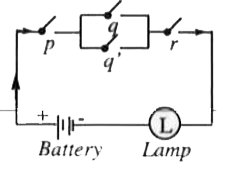When the current i is flowing through a conductor, the drift velocity is v . If 2i current is flowed through the same metal but having double the area of cross-section, then the drift velocity will be
v/4
v/2
v
4v
The correct Answer is:C
To solve the problem, we will use the relationship between current, drift velocity, and the area of cross-section of the conductor.
1. Understand the relationship between current, drift velocity, and area:
The current I flowing through a conductor can be expressed using the formula:
I=n⋅e⋅A⋅vd
where:
- n = number density of charge carriers (electrons),
- e = charge of an electron,
- A = area of cross-section,
- vd = drift velocity.
2. Set up the initial condition:
Let the initial current be I=i and the initial drift velocity be vd=v. Thus, we can write:
i=n⋅e⋅A⋅v
3. Consider the new conditions:
Now, we have a new current I′=2i flowing through the same metal but with double the area of cross-section A′=2A. We need to find the new drift velocity v′d.
4. Write the equation for the new current:
Using the same formula for the new conditions:
I′=n⋅e⋅A′⋅v′d
Substituting A′=2A and I′=2i:
2i=n⋅e⋅(2A)⋅v′d
5. Relate the two equations:
From the first equation, we have:
i=n⋅e⋅A⋅v
Now, substituting this into the equation for I′:
2(n⋅e⋅A⋅v)=n⋅e⋅(2A)⋅v′d
6. Simplify the equation:
Cancel n⋅e from both sides (assuming n and e are constants):
2A⋅v=2A⋅v′d
Dividing both sides by 2A:
v=v′d
7. Conclusion:
The new drift velocity v′d is equal to the original drift velocity v:
v′d=v
Final Answer:
The drift velocity when 2i current is flowed through the same metal with double the area of cross-section is v.
The current I flowing through a conductor can be expressed using the formula:
I=n⋅e⋅A⋅vd
where:
- n = number density of charge carriers (electrons),
- e = charge of an electron,
- A = area of cross-section,
- vd = drift velocity.
Let the initial current be I=i and the initial drift velocity be vd=v. Thus, we can write:
i=n⋅e⋅A⋅v
Now, we have a new current I′=2i flowing through the same metal but with double the area of cross-section A′=2A. We need to find the new drift velocity v′d.
Using the same formula for the new conditions:
I′=n⋅e⋅A′⋅v′d
Substituting A′=2A and I′=2i:
2i=n⋅e⋅(2A)⋅v′d
From the first equation, we have:
i=n⋅e⋅A⋅v
Now, substituting this into the equation for I′:
2(n⋅e⋅A⋅v)=n⋅e⋅(2A)⋅v′d
Cancel n⋅e from both sides (assuming n and e are constants):
2A⋅v=2A⋅v′d
Dividing both sides by 2A:
v=v′d
The new drift velocity v′d is equal to the original drift velocity v:
v′d=v
The drift velocity when 2i current is flowed through the same metal with double the area of cross-section is v.
Topper's Solved these Questions
- CURRENT ELECTRICITYBook:DC PANDEY ENGLISHChapter:CURRENT ELECTRICITYExercise:Taking it together
Explore 142 Videos
- CURRENT ELECTRICITYBook:DC PANDEY ENGLISHChapter:CURRENT ELECTRICITYExercise:B. Assertion and reason
Explore 18 Videos
- CURRENT ELECTRICITYBook:DC PANDEY ENGLISHChapter:CURRENT ELECTRICITYExercise:Example
Explore 65 Videos
- COMMUNICATION SYSTEMBook:DC PANDEY ENGLISHChapter:COMMUNICATION SYSTEMExercise:Subjective
Explore 11 Videos
- ELECTROMAGNETIC INDUCTIONBook:DC PANDEY ENGLISHChapter:ELECTROMAGNETIC INDUCTIONExercise:Medical entrances gallery
Explore 25 Videos
Similar Questions
When a current passes through a resistor, its temperature increases. Is it an adiabatic process?
View SolutionWhen current flows through a conductor, then the order of drift velocity of electrons will be
View SolutionWhen current is 4 A in a conductor the drift velocity is vd. When the current is 3 A the drift velocity will be
View SolutionWhen a steady current flows through a metal conductor of non-uniform cross-section , then drift velocity is
View SolutionWhen does the current flow through the following circuit ?

View SolutionThe water flowing through the same tube having two different cross section areas has different flow rates .
View SolutionA stready current i is flowing through a conductor of uniform cross-section. Any segment of the conductor has
View SolutionThe drift velocity of free electrons in a conductor is v, when a current i is flowing in it, Ifboth the radius and current are doubled, then the drift velocity will be :
View SolutionA steady electric current is flowing through a cylindrical conductor. Then,
View SolutionA current of 1.5A flows through a conductor for 2.0s. What amount of charge passes through the conductor ?
View Solution
